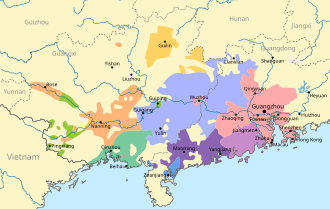Cantonese
Cantonese (traditional Chinese: 廣東話; simplified Chinese: 广东话; Yale: Gwóngdūng wá) is a language within the Chinese (Sinitic) branch of the Sino-Tibetan languages originating from the city of Guangzhou (historically known as Canton) and its surrounding area in Southeastern China. It is the traditional prestige variety of the Yue Chinese dialect group, which has over 80 million native speakers.[1] While the term Cantonese specifically refers to the prestige variety, it is often used to refer to the entire Yue subgroup of Chinese, including related but largely mutually unintelligible languages and dialects such as Taishanese.
Cantonese is viewed as a vital and inseparable part of the cultural identity for its native speakers across large swaths of Southeastern China, Hong Kong and Macau, as well as in overseas communities. In mainland China, it is the lingua franca of the province of Guangdong (being the majority language of the Pearl River Delta) and neighbouring areas such as Guangxi. It is also the dominant and co-official language of Hong Kong and Macau. Cantonese is also widely spoken amongst Overseas Chinese in Southeast Asia (most notably in Vietnam and Malaysia, as well as in Singapore and Cambodia to a lesser extent) and throughout the Western world.
Although Cantonese shares much vocabulary with Mandarin, the two Sinitic languages are mutually unintelligible, largely because of phonological differences, but also due to differences in grammar and vocabulary. Sentence structure, in particular the placement of verbs, sometimes differs between the two varieties. A notable difference between Cantonese and Mandarin is how the spoken word is written; both can be recorded verbatim, but very few Cantonese speakers are knowledgeable in the full Cantonese written vocabulary, so a non-verbatim formalized written form is adopted, which is more akin to the Mandarin written form.[2][3]This results in the situation in which a Cantonese and a Mandarin text may look similar but are pronounced differently.
In English, the term "Cantonese" can be ambiguous. Cantonese proper is the variety native to the city of Canton, which is the traditional English name of Guangzhou. This narrow sense may be specified as "Canton language"[4] or "Guangzhou language".[5]
However, "Cantonese" may also refer to the primary branch of Chinese that contains Cantonese proper as well as Taishanese and Gaoyang; this broader usage may be specified as "Yue speech" (粵語; 粤语; Yuhtyúh). In this article, "Cantonese" is used for Cantonese proper.
Historically, speakers called this variety "Canton speech" (廣州話; 广州话; Gwóngjāu wá), although this term is now seldom used outside mainland China. In Guangdong and Guangxi, people also call it "provincial capital speech" (省城話; 省城话; Sáangsìng wá) or "plain speech" (白話; 白话; Baahkwá). Also, academically called "Canton prefecture speech" (廣府話; 广府话; Gwóngfú wá).[citation needed]


